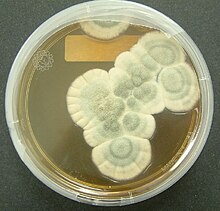Penicillium chrysogenum
| Penicillium chrysogenum | |
|---|---|

| |
| Scientific classification | |
| Domain: | Eukaryota |
| Kingdom: | Fungi |
| Division: | Ascomycota |
| Class: | Eurotiomycetes |
| Order: | Eurotiales |
| Family: | Aspergillaceae |
| Genus: | Penicillium |
| Species: | P. chrysogenum
|
| Binomial name | |
| Penicillium chrysogenum Thom (1910)
| |
Penicillium chrysogenum (formerly known as Penicillium notatum) is a species of fungus in the genus
Like the many other species of the genus
The airborne asexual spores of P. chrysogenum are important human allergens. Vacuolar and alkaline serine proteases have been implicated as the major allergenic proteins.[17]
P. chrysogenum has been used industrially to produce penicillin and
Science
The discovery of
History
Genetics and evolution
The ability to produce penicillin appears to have evolved over millions of years, and is shared with several other related fungi. It is believed to confer a selective advantage during competition with bacteria for food sources.[citation needed] Some bacteria have consequently developed the counter-ability to survive penicillin exposure by producing penicillinases, enzymes that degrade penicillin.[citation needed] Penicillinase production is one mechanism by which bacteria can become penicillin resistant.
The principal genes responsible for producing penicillin, pcbAB, pcbC, and penDE are closely linked, forming a cluster on chromosome I.[19] Some high-producing Penicillium chrysogenum strains used for the industrial production of penicillin contain multiple tandem copies of the penicillin gene cluster.[20]
Similar to other filamentous fungi,
References
- ^ Samson RA, Houbraken J, Thrane U, Frisvad JC, Andersen B (2010). Food and Indoor Fungi. Utrecht, the Netherlands: CBS-KNAW- Fungal Biodiversity Centre. pp. 1–398.
- PMID 21531835.
- S2CID 41843432.
- PMID 22679592.
- PMID 23606767.
- PMID 12387776.
- PMID 23776469.
- PMID 29196288.
- PMID 30524395.
- PMID 29575742.
- .
- PMID 24887561.
- PMID 27107123.
- PMID 28618182.
- ^ a b de Hoog GS, Guarro J, Gené J, Figueras F (2000), Atlas of Clinical Fungi - 2nd Edition, Centraalbureau voor Schimmelcultures (Utrecht)
- PMID 23307807.
- S2CID 28229046.
- ^ Raper KB, Thom C (1949). A manual of the Penicillia. Williams & Wilkins Company (Baltimore).
- S2CID 25327312.
- PMID 7597101.
- S2CID 206764457.
External links
- "Penicillium chrysogenum". Tom Volk's fungus of the month.
